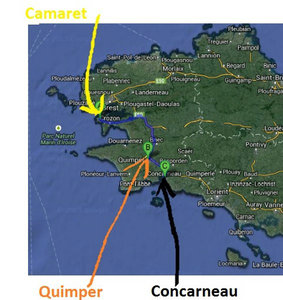Advertisement
Published: July 30th 2013

 Where Were We?
Where Were We?
Camaret is where we sailed to and we took the bus to the other 2 towns shown here.On July 10
th we decided to do another bus trip starting from Camaret. We had to go to Quimper again, then change buses for the ½ hour trip to Concarneau. We picked this town to travel to because it was one that we would have sailed to on the south coast of Brittany if we hadn’t made the crossing directly to Camaret from Spain. Reading about the town we found that it originally was built on an islet and a fortified wall was built around it in the 14
th century. It was captured by the English in 1373. In the second part of the 15
thcentury it was decided that the fortification needed to be improved so towers were added. By the 18th century the port had declined in importance and thus had been spared much of the destruction which occurred in other ports during the wars in Europe.
Concarneau is one of the most touristy areas we have been to so far with lots of crowds, but we still enjoyed the day here. Walking around the fortress area gave us a great view of the harbor and city. One place that was the least touristy but had received high marks

 View from the Bus Stop
View from the Bus Stop
When you get off the bus in Concarneau this is the first view you have of the walled city that is located in an island. when reading about it in TripAdvisor (an extremely useful website that rates not only restaurants and hotels but also museums and other points of interest) was the Museum about the fishing industry which is so important in this area. It is a small place, but it was very informative and the displays were well done. All the labels were in French, but they did have an English guide that you could use which helped. Fortunately the displays were clear enough that they didn’t require translation. A retired fishing trawler was also part of the museum so we were able to climb onboard and see how the crew lived while at sea. After going through the exhibits we got a much better appreciation for all the work that is involved in putting fish on our dinner plates.
We knew we would be leaving Brittany soon so of course had to partake of their local specialties – Bob had mussels cooked in a wine and cream sauce and Janice had excellent crepes. We both sampled the local cider and discovered another great delight of this part of France.
A successful day’s outing gave us a chance to see a little

 Fishing Boats Tied Up
Fishing Boats Tied Up
A view of the town with the many colorful small fishing boats tied up in the area near the walled city.more of Brittany. It is a very pleasant area and we highly recommend it as a place to visit if you are looking for a vacation idea! Just beware that July is the time for the French to take their holidays and places are crowded.
The bus connection worked out well with only a 20 minute layover for the bus to Camaret. We have been fortunate to have been able to use the public transportation system up to now as it lets us look around the countryside and it definitely is less expensive then renting a car. Luckily even in a foreign language the bus schedules are pretty easy to figure out!
Advertisement
Tot: 0.153s; Tpl: 0.013s; cc: 10; qc: 31; dbt: 0.114s; 1; m:domysql w:travelblog (10.17.0.13); sld: 1;
; mem: 1.1mb

 Where Were We?
Where Were We?
 View from the Bus Stop
View from the Bus Stop
 Fishing Boats Tied Up
Fishing Boats Tied Up


























